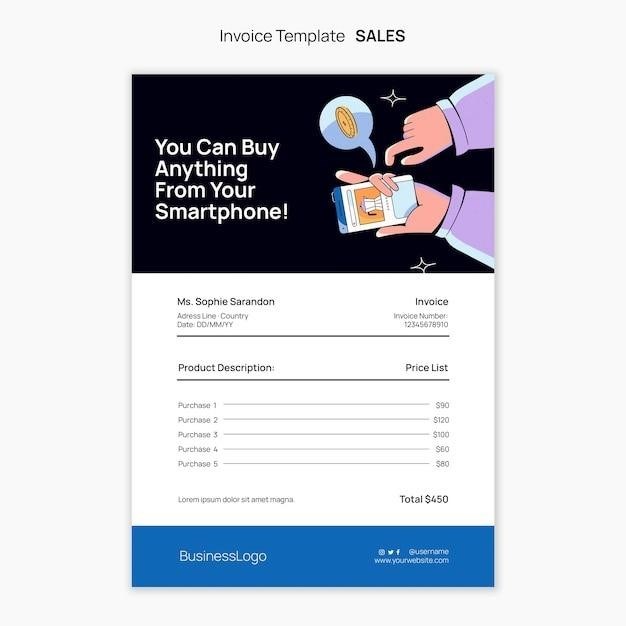Commerce Acquisition Manual⁚ A Comprehensive Guide
This manual provides a detailed guide to the acquisition of goods and services by the Department of Commerce. It outlines the policies, procedures, and best practices for effective and efficient acquisition processes, ensuring compliance with federal regulations and maximizing value for the government.

Introduction
The Commerce Acquisition Manual (CAM) serves as a comprehensive guide for navigating the complex landscape of government acquisitions within the Department of Commerce. It encompasses a wide range of topics, from fundamental principles to specific procedures, ensuring adherence to legal and regulatory frameworks. The CAM aims to foster a culture of transparency, accountability, and efficiency in procurement practices, enabling the Department to effectively acquire the goods and services necessary to fulfill its mission.
This manual is a valuable resource for all stakeholders involved in the acquisition process, including procurement officers, program managers, contracting officers, and other personnel; It provides a clear roadmap for navigating the intricacies of acquisition regulations, promoting consistency and standardization across departmental activities. The CAM’s overarching goal is to empower the Department of Commerce to make informed and strategic acquisition decisions, ultimately contributing to the success of its programs and initiatives.
Importance of Commerce Acquisition
Commerce acquisition is a critical function that underpins the Department of Commerce’s ability to fulfill its mission. Through effective acquisition practices, the Department secures the necessary goods and services to support its diverse programs and initiatives. This includes everything from technology and infrastructure to research and development, all of which contribute to the advancement of economic growth, innovation, and national competitiveness.
Furthermore, commerce acquisition plays a vital role in ensuring the efficient and effective use of taxpayer dollars. By adhering to rigorous procurement processes, the Department can maximize value for money, minimizing waste and ensuring that resources are allocated strategically. This commitment to responsible spending is essential for maintaining public trust and demonstrating the Department’s commitment to fiscal accountability.
Types of Acquisitions
The Department of Commerce employs a variety of acquisition methods to procure the goods and services it needs. These methods are tailored to the specific requirements of each acquisition, ensuring that the Department obtains the best value for its investments. Some common types of acquisitions include⁚
- Competitive Bidding⁚ This method involves soliciting bids from multiple vendors and awarding the contract to the vendor offering the most advantageous terms. Competitive bidding promotes fair competition and helps ensure that the Department obtains the best possible price.
- Negotiated Procurement⁚ When competitive bidding is not feasible, the Department may engage in negotiated procurement. This involves discussions with potential vendors to reach a mutually agreeable contract. Negotiated procurement is often used for complex acquisitions or when specific technical expertise is required.
- Simplified Acquisition Procedures⁚ For smaller acquisitions, the Department may use simplified acquisition procedures, which streamline the procurement process. This can involve using government-wide commercial purchase cards or other expedited methods for acquiring goods and services.
The specific acquisition method employed will depend on factors such as the value of the acquisition, the complexity of the requirements, and the time frame involved.
Key Considerations for Commerce Acquisitions
Successful commerce acquisitions require careful planning and consideration of various factors. The following key considerations are crucial for achieving successful outcomes⁚
- Market Research⁚ Thorough market research is essential to identify potential acquisition targets that align with the Department’s strategic goals. This research should include analysis of the target’s financial performance, market position, and potential synergies with the Department.
- Legal and Regulatory Compliance⁚ Commerce acquisitions are subject to various legal and regulatory requirements, including antitrust laws, environmental regulations, and labor laws. It is crucial to ensure that all applicable laws and regulations are adhered to throughout the acquisition process.
- Due Diligence⁚ A comprehensive due diligence process is essential to assess the target’s financial condition, legal liabilities, and operational performance. This process should involve independent audits and legal reviews to ensure that the acquisition is a sound investment.
- Integration Planning⁚ Effective integration planning is critical for ensuring a smooth transition after the acquisition. This includes developing strategies for merging operations, integrating systems, and managing the target’s workforce.
By carefully addressing these key considerations, the Department can minimize risks and maximize the benefits of commerce acquisitions.
The Commerce Acquisition Manual (CAM)
The Commerce Acquisition Manual (CAM) serves as a comprehensive guide for the Department of Commerce’s acquisition activities. It provides detailed policies, procedures, and guidance on various aspects of acquiring goods and services, ensuring compliance with federal regulations and promoting efficiency. The CAM is structured to complement the Federal Acquisition Regulation (FAR), providing specific guidance for the Department’s unique needs and context.
The CAM covers a wide range of topics, including⁚
- Planning and Requirements Development⁚ Defining acquisition objectives, developing specifications, and conducting market research.
- Contract Types and Award Methods⁚ Selecting the appropriate contract type and award method for different acquisition scenarios.
- Contract Administration⁚ Managing contract performance, resolving disputes, and ensuring compliance.
- Financial Management⁚ Budget planning, cost analysis, and funding authorization.
The CAM is a valuable resource for all Department of Commerce personnel involved in acquisition activities, providing a clear framework for navigating the complex world of government procurement.
The Role of the Department of Commerce
The Department of Commerce plays a pivotal role in fostering a robust and competitive American economy. Through its various agencies and programs, it supports businesses, promotes innovation, and strengthens U.S. competitiveness in global markets. This commitment extends to its acquisition activities, which are guided by the Commerce Acquisition Manual (CAM).
The Department’s acquisitions are strategically aligned with its mission to⁚
- Promote Economic Growth⁚ By acquiring goods and services that support business development, job creation, and technological advancements.
- Protect Consumers⁚ Ensuring the safety and quality of products and services acquired for the public good.
- Enhance National Security⁚ Acquiring technology and equipment that contribute to national security and defense.
- Advance Scientific Research⁚ Supporting research and development initiatives that drive innovation and economic growth.
The Department’s acquisition practices are designed to achieve these objectives while adhering to principles of efficiency, transparency, and accountability.
The Acquisition Process
The Department of Commerce acquisition process is a comprehensive and structured approach designed to ensure the efficient and effective procurement of goods and services. This process involves several key stages, each with specific objectives and requirements⁚
- Planning and Requirements Definition⁚ This stage involves identifying the need for goods or services, defining specific requirements, and establishing a budget for the acquisition.
- Market Research and Solicitation⁚ The Department conducts thorough market research to identify potential suppliers and develops solicitations (e.g., Requests for Proposals, Invitations for Bids) to communicate requirements and gather proposals.
- Evaluation and Selection⁚ Proposals are evaluated based on established criteria, including technical capabilities, pricing, and past performance. The Department selects the most suitable supplier for the acquisition.
- Negotiation and Contract Award⁚ Negotiations are conducted with the selected supplier to finalize contract terms, including pricing, delivery schedules, and performance standards. The contract is then awarded to the chosen supplier.
- Contract Administration and Oversight⁚ The Department monitors contract performance, ensuring compliance with agreed-upon terms and resolving any disputes or issues that may arise.
- Contract Closeout⁚ Upon completion of the contract, the Department conducts a formal closeout process to ensure all deliverables have been received and payments have been made.
This systematic process ensures that the Department acquires the necessary goods and services in a timely and cost-effective manner while maintaining high standards of quality and accountability.
Best Practices for Commerce Acquisitions
The Department of Commerce emphasizes a set of best practices to optimize acquisition processes, ensuring efficiency, transparency, and value for the government. These practices include⁚
- Early Engagement with Stakeholders⁚ Fostering communication and collaboration with relevant stakeholders, including program managers, technical experts, and legal counsel, throughout the acquisition process to ensure alignment and address potential issues proactively.
- Competitive Sourcing⁚ Utilizing competitive sourcing strategies, such as open competition, to maximize value and ensure fair and transparent selection of suppliers.
- Risk Management⁚ Identifying and mitigating potential risks throughout the acquisition lifecycle through thorough planning, risk assessments, and contingency planning.
- Contractual Clarity⁚ Establishing clear and concise contract terms that define responsibilities, deliverables, performance standards, and payment terms, minimizing ambiguity and potential disputes.
- Performance Monitoring and Evaluation⁚ Continuously monitoring supplier performance against contract requirements and conducting regular evaluations to identify areas for improvement and ensure contract compliance.
- Knowledge Sharing and Continuous Improvement⁚ Sharing lessons learned and best practices across the Department to foster continuous improvement and enhance future acquisition processes.
By adhering to these best practices, the Department of Commerce aims to achieve successful acquisitions that meet program needs, deliver value for taxpayers, and promote ethical and responsible procurement practices.
Case Studies of Successful Acquisitions
The Department of Commerce has a history of successful acquisitions that have significantly contributed to its mission and objectives. These case studies highlight the effectiveness of the acquisition process and the positive outcomes achieved.
- Acquisition of GCommerce⁚ In 2022, SPS Commerce, a leader in retail cloud services, acquired GCommerce, a leading EDI provider within the automotive aftermarket industry. This acquisition strengthened SPS Commerce’s leadership in the automotive aftermarket industry, expanding its reach and capabilities in the sector.
- Acquisition of The Stable⁚ Accenture, a global professional services company, completed its acquisition of The Stable, a commerce agency focused on helping consumer brands build and operate their own digital commerce channels. This acquisition enhanced Accenture’s digital commerce capabilities, enabling them to provide comprehensive solutions to clients in the evolving e-commerce landscape.
- Acquisition of BeProfit⁚ Viably, a leader in e-commerce financial solutions, acquired BeProfit, a profit analysis tool, to expand its all-in-one platform. This acquisition integrated BeProfit’s capabilities into Viably’s platform, providing businesses with comprehensive financial insights and tools to optimize profitability.
These case studies demonstrate the successful implementation of the Department of Commerce’s acquisition process, resulting in strategic partnerships, enhanced capabilities, and positive outcomes for both the Department and the acquired entities.
The Commerce Acquisition Manual (CAM) serves as a comprehensive guide for the Department of Commerce’s acquisition activities, ensuring efficient, effective, and compliant processes. By adhering to the principles outlined in the CAM, the Department can maximize value for the government, fostering a culture of transparency, accountability, and excellence in acquisition.

The CAM emphasizes the importance of strategic planning, thorough market research, and robust competition to ensure the selection of the best possible vendors. It also underscores the need for strong contract management and oversight to guarantee the timely and successful delivery of goods and services.
Through continuous improvement and adherence to the principles outlined in the CAM, the Department of Commerce can continue to achieve its mission effectively, leveraging acquisition strategies to enhance its capabilities, promote innovation, and contribute to the nation’s economic growth and prosperity.
Resources
For further information and guidance on commerce acquisition, the following resources are available⁚
- Department of Commerce Acquisition Regulation (CAR)⁚ This regulation provides the overarching framework for all acquisition activities within the Department of Commerce, supplementing the Federal Acquisition Regulation (FAR). It can be accessed on the Department of Commerce website.
- Commerce Acquisition Manual (CAM)⁚ This manual provides detailed guidance on specific aspects of acquisition, including policies, procedures, and best practices. It can be found on the Department of Commerce website.
- Federal Acquisition Regulation (FAR)⁚ This regulation sets forth the basic policies and procedures for acquisition by all executive agencies of the U.S. Government, including the Department of Commerce. It is available online through the Federal Acquisition Regulation website.
- Office of Acquisition Management, U.S. Department of Commerce⁚ This office provides guidance and support for acquisition professionals within the Department. Their contact information can be found on the Department of Commerce website.
These resources provide comprehensive information to support the effective and compliant implementation of commerce acquisition processes within the Department of Commerce.
